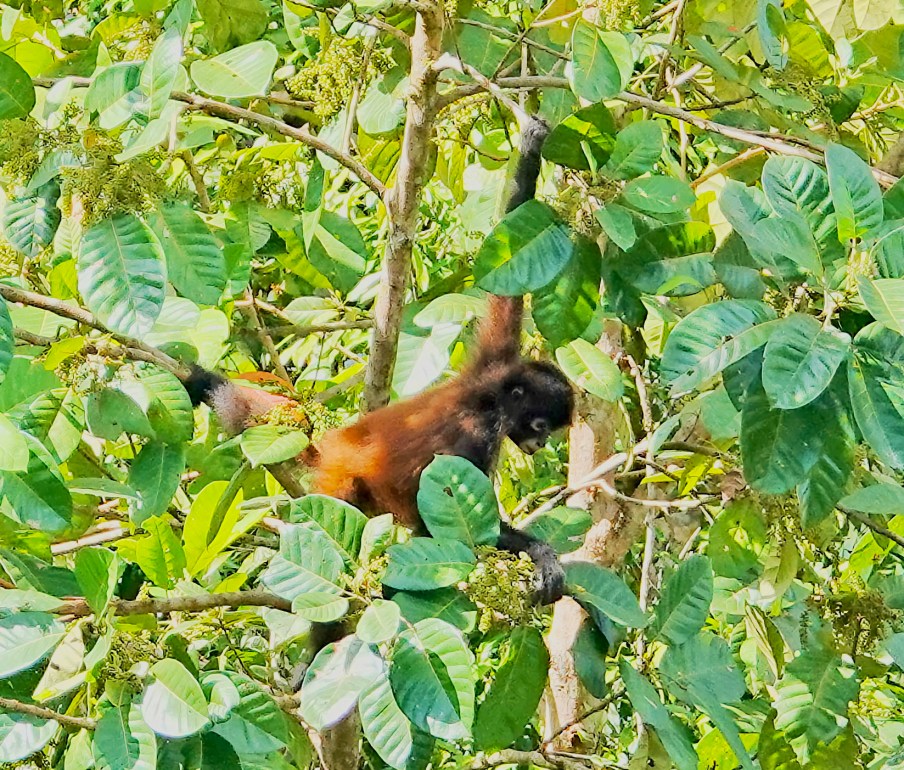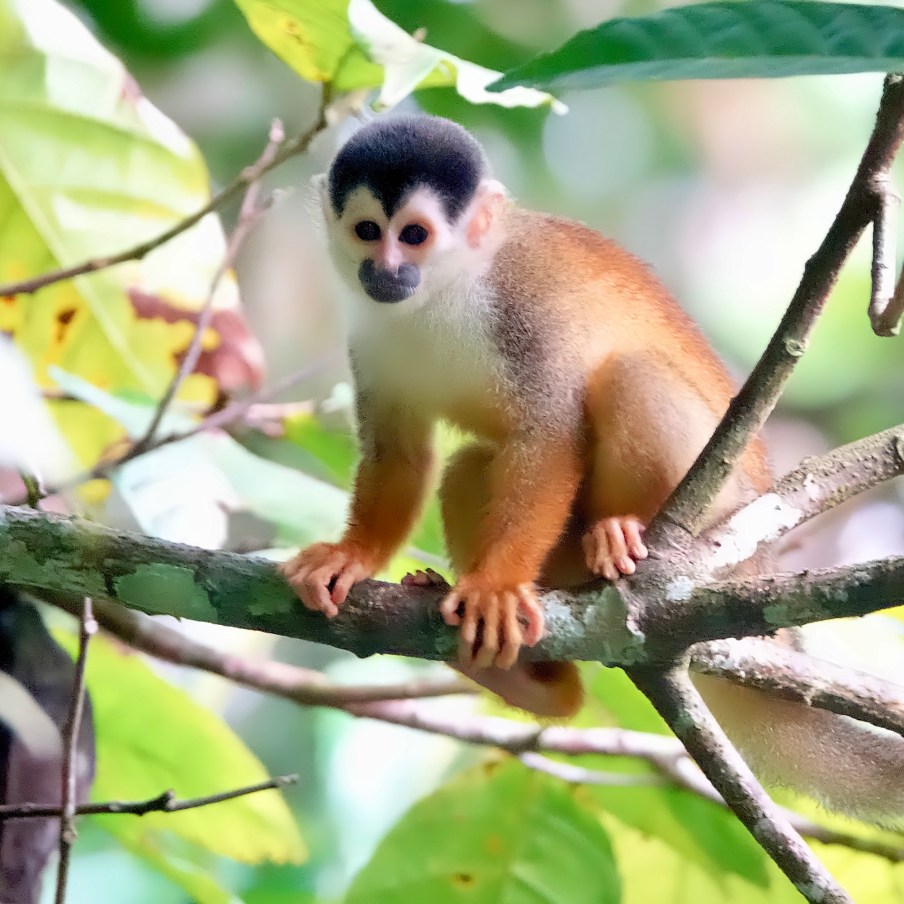Posts in Category: monkey
Osa Howlers


Howler Monkeys: Rio Rincon near Danta Corcovado Lodge, Osa Peninsula, Costa Rica — The Osa Peninsula is home to all 4 of Costa Rica’s primate species. We encountered a troop of Howler Monkeys along the bed of the Rincon well into Corcovodo National Park, near the Ranger Station. The Howler is the second largest monkey in Costa Rica, but as mentioned before, it always manages to look bigger than the larger Spider Monkey, perhaps due to its relatively massive proportions…all body and tail, and not so much legs and arms. Sony Rx10iv at 600mm equivalent. Program mode with my custom birds and wildlife modifications. Processed in Pixelmator Photo and Apple Photos. ISO 500 and 250 @ f4 @ 1/500th.
Spider Monkey!


Spider Monkey: Rio Rincon near Danta Corcovado Lodge, Corcovado National Park, Osa Peninsula, Costa Rica — I had never seen the Spider Monkey in Costa Rica…and on my one trip to the Amazon, I was sick aboard the river boat when they were seen in Peru…so I was delighted when we spotted a few in a very tall tree beside the Rincon as we drove our tractor and wagon up the riverbed on our way deep into Corcovado National Park. The Spider Monkey, despite it’s somewhat delicate look when compared to the more common Howler Monkey, is actually the largest of the primates in Costa Rica. Though we never got a really unobstructed view of the Spider, you can see the length of the arms and at least glimpse the length of the tail. This is an animal made for moving rapidly through the canopy. Sony Rx10iv at 600mm equivalent. Program mode with my custom birds and wildlife modifications. Processed in Pixelmator Photo and Apple Photos. ISO 125 @ f4 @ 1/500th.
Squirrel Monkeys



Squirrel Monkeys: Danta Corcovado Lodge, Puerto Jimenez, Costa Rica (Osa Peninsula) — Very active monkeys in very bad light. 🙂 This troop of Squirrel Monkeys comes to hand out in the prickly palms over the main lodge buildings at Danta Corcovado each evening…bordering on full dark. These conditions push any camera to its limits. This was our first night at the lodge, and we were on our way back from sunset on the observation tour on the hill behind the lodge. Sony Rx10iv at 458, 124, and 493mm equivalents. Program mode with wildlife modifications and multi-frame noise reduction. Processed in Pixelmator Photo and Apple Photos.
Howlers of the Sarapique






Howler Monkeys: Sarapique River at Puerto Viejo, Costa Rica — the Howler Monkey is by far the most abundant primate in the lowland rain forests of Costa Rica, at least on the Caribbean slope. The resident troop woke us up most mornings at 4am as the males greeted the day and proclaimed their dominance. We saw this troop from the safari boat on the Sarapique River, upstream from the docks at Puerto Viejo. The big male is pretty obvious. The female with the baby was good to see, and the young male was very active. There were several more in the troop, but they stayed deeper in and out of sight. Sony Rx10iv at 509mm equivalent (trying to get the tails in :). Program mode with my custom birds and wildlife modifications. Processed in Pixelmator Photo and Apple Photos. Mostly ISO 800, one at ISO 1000 and one at 640. f4 @ 1/500th.
Howler

Howler Monkey: from a boat on the Sarapiqui River near Puerto Viejo, Costa Rica. We saw 4 species of primate during our two weeks in Costa Rica…not counting the ubiquitous humans…but only had really good looks at this troop of Howlers along the Sarapiqui river. Of course, we heard the Howlers every morning, between 4:30 and 5am, at lodges in both the Caribbean and Pacific lowlands. I was somewhat surprised to find that the Howlers are not the largest monkeys in Costa Rica…a fact that does not seem to be causing this particular Howler much worry…so I guess it should not worry me. (The Spider Monkey is larger.) The thing about primates, at least for me, is that they appear to be self-conscious, which makes me more than usually aware of our kinship. Sony Rx10iv at 509mm equivalent (to fit the tail in). Program mode with my custom birds and wildlife modifications. Processed in Pixelmator Photo and Apple Photos. ISO 1000 @ f4 @ 1/500th.
Bwindi Monkeys
Bwindi Impenetrable Forest National Park is home to 10 primate species, from the Mountain Gorilla and Chimpanzee to small nocturnal monkeys. On our way to our lodge in the center of Bwindi, Moses, our sharp-eyed guide, spotted a group of monkeys working in a tree just off the road, and we stopped to see what was what. Of course, most of the monkeys took off deeper into the forest, but individuals of two species hung around long enough for photos.

This is the Red-tailed Monkey, also known as the “black-cheeked white-nosed monkey,” “red-tailed guenon,” redtail monkey,” or “Schmidt’s guenon”, depending on what reference you check. This is the best shot I managed before the whole troop disappeared, but you can pick out all of the features that give it its various names.

The somewhat larger Blue Monkeys in the tree were bolder and hung around longer, giving me more opportunities for photos. They were also more curious and actually came down closer to see what we were up to down on their road. Notice the length of that tail!


We had not been back and continuing our journey more than 5 minuets when we drove up beside another Bwindi monkey. It took two tries. The first scampered away and a few moments later we managed to roll to a stop beside this L’Hoest’s Monkey, who was busy with something in the short grass along the road. L’Hoest’s are generally shy, and I feel privileged to have gotten this shot.
Sony Rx10iv at various focal lengths as needed to frame. Program mode with my custom birds and wildlife modifications. Processed in Polarr and Apple Photos.
Petas Monkey


Our third (out of 9) primate species on my September #Epic_Uganda_Vacations birds and wildlife safari in Uganda’s National Parks and Reserves. This fellow is in Murchinson Falls National Park. He climbed up to greet the first rays of the rising sun (and maybe to keep a better eye on us as we stopped on the road near him). They are more commonly seen foraging on the ground, and, indeed, that is where we saw our first one. This one presented itself a half hour later and further into the drive. Given their common social structure…they live and forage in troops of up to 25…there were probably a lot more of them out of sight in the long grasses under the acacia trees below. Sony RX10iv at 600 and 1200mm equivalents. Program mode with my custom birds and wildlife modifications. Processed in Polarr and Apple Photos. The heavy brow and the dark eye-sockets make the eyes hard to recover but you can see a hint of them in the closer view. 🙂
Year of the Monkey

Howler Monkey, Cuero y Salado NWR, Honduras
I gather from various posts on the internet that it is the Chinese Year of the Monkey. Last year when we visited Honduras we saw no monkeys at all. This year we saw two troops of Howlers and two troops of White-faced Capuchins. The Howlers were in the forest beside the Cuero y Salado rivers on our visit to the Wildlife Refuge there, as was one of the troops of Capuchins. The other troop of Capuchins was high on one of the trails above Rio Santiago. This shot is from the moving boat on the rivers. I had only a second to grab it as the Howler was working in and out of the vegetation. Not a zoo shot at all. In the wild you take the chances you get. 🙂
Nikon P900 at 2000mm equivalent field of view. 1/200th @ ISO 400 @ f6.5. Processed in Lightroom.
Howler
It is not all birds on the ZEISS/Eagle Optics VICTORY SF Experience at Pico Bonito Lodge in Honduras. One of the treats on today’s visit to Cuero y Saado Wildlife Refuge was a troop of Howler Monkeys resting in the trees. You may have seen them in zoos, but there is nothing like seeing them in the wild.
Nikon P900 at 500mm equivalent field of view. 1/250th @ ISO 200 @ f5. Processed in Lightroom.
